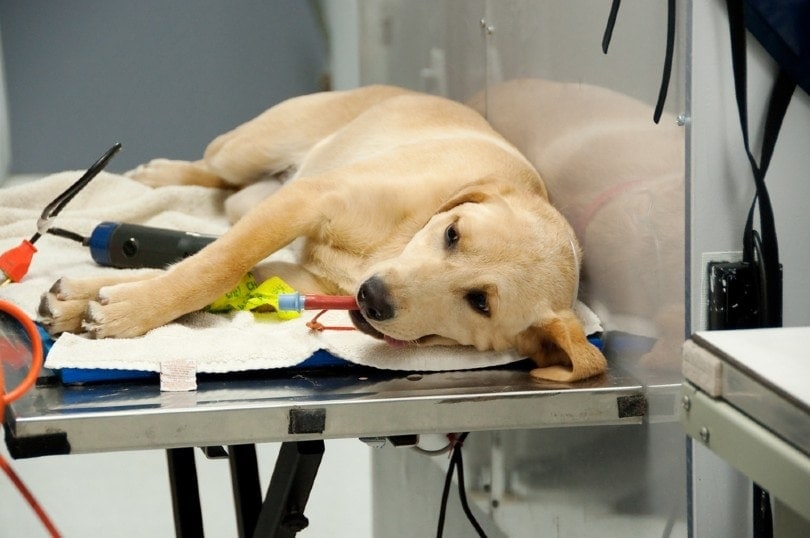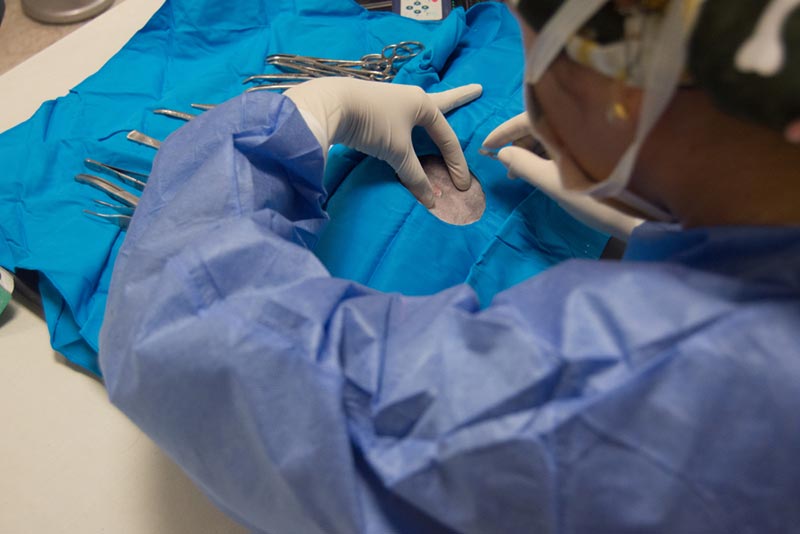What Is the Cost of Spaying or Neutering a Dog in the UK? Updated in 2024

Updated on

Click to Skip Ahead
When you’re getting a new pet, you tend to factor in costs like insurance, food, and toys, but there are some costs you don’t realize could be an issue, until they already are a problem. Spaying or neutering your dog is one of these costs and it’s one many pet parents in the UK choose to spend their money on. The cost of spaying or neutering a dog in the UK can vary widely depending on factors such as the size of the dog, location, veterinary clinic, and any additional services, but it generally ranges from around £100 to £300 or more.
So, why do people choose to spay or neuter their dogs, and how much will it end up costing you? We’ve got these answers and more!
The Importance of Spaying or Neutering Your Dog
There are many reasons owners choose to get their dog spayed or neutered. The first thing you should do is contact your veterinarian, as there might be different risks and benefits depending on your dog’s health, age, and breed.
Generally, however, the positive benefits for males are that neutering reduces:
- Humping behaviors
- Risk of certain types of cancer, such as prostate cancer
- Risk of unwanted puppies
- Urine marking and roaming
Your female dog will be less moody once she’s been spayed because her hormones won’t be affected by her being in heat/coming into season. Other positives of spaying a female dog are:
- Helps prevent ovarian tumors
- Prevents unwanted pregnancy/phantom pregnancy
- Removes the risk of pyometra (womb infections)
- Reduces the risk of mammary cancer

How Much Does Spaying or Neutering Your Dog Cost?
Research shows that you should expect to pay about £200 to neuter your male dog and £300 for a female. Apart from gender, prices will also vary depending on:
- If you choose advanced treatments: chemical castration or laparoscopic spay
- Size and weight of the dog
- The area you live in
- The vet practice you’re with
On average, it’s around 35% more expensive to spay a female than it is to neuter a male. The reasons for this are that the surgery for a female takes longer, it’s more intrusive, and there is more aftercare required. The average, nationwide cost to neuter a male is £221.12 while the average cost for spaying a female is £299.22.
So, what exactly is the difference between both procedures? Neutering, also known as castration, involves removing both testicles, while spaying involves removing both ovaries and the womb. There is also a newer method of ovariectomy, which is done laparoscopically and removes just the ovaries.
| Low Price | Average Price | High Price | |
| Neuter Male Dog | £100 | £221.12 | £450 |
| Spay Female Dog | £150 | £299.22 | £646 |
Neutering Costs and the Size of Your Dog
It might seem like there’s a big difference between the lowest and highest prices, and the reason for this is that neutering is cheaper for smaller dogs. On average, the price of castrating a small dog is £126.29 whereas the average for a large dog is £246.02.
| Low Price | Average Price | High Price | |
| Small Dog | £150 | £196.29 | £328 |
| Medium Dog | £100 | £221.06 | £368.69 |
| Large Dog | £100 | £246.02 | £450 |
This is also true for spaying a female dog. The average cost for spaying a small dog is £267.03 whereas the average for a large dog is £331.61.
| Low Price | Average Price | High Price | |
| Small Dog | £150 | £267.03 | £600 |
| Medium Dog | £150 | £299.04 | £331.61 |
| Large Dog | £200 | £331.61 | £646 |
When vets refer to small, medium, and large, generally this meant a dog under 55 pounds is considered small, around 55 to 100 pounds for medium, and over 100 pounds for large dogs. These classifications will vary depending on the vet clinic, so these are just average numbers.
Some vets, generally not-for-profit vets like Animal Trust, tend to charge a fixed price for all sizes of dogs. They charge £169 to neuter any male dog and £239 to spay any size female dog.
What Does the Cost of Neutering Include?
When you’re comparing prices, make sure what you’re comparing is like-for-like. As you can see, the size of a dog really changes what you should expect to pay, so when vets only quote one price by stating prices “start from” this generally means this is the price for a small dog. So, if you’ve got a larger dog, you should expect to pay more.
You will also want to make sure that the price you’re quoted includes pre- and post-operative check-ups. Most will do because the price should include this, but if it doesn’t, expect to pay an extra £25–£35 per visit. And finally, the price should also include the cost of a cone and pain relief.

Chemical Castration
There is an option to chemically castrate your dog. This involves placing a chip or implant under the skin. This chip contains the hormone medication “Supralorin” which will reduce your dog’s testosterone and makes them temporarily infertile for 6 to 12 months.
This procedure isn’t widely available in the UK, so you’re unlikely to see a price listed for this with your local vet. Many Pets quoted New Priory Vets in Brighton as offering the procedure for £109.48 for the 6-month implant and £218.96 for the implant that lasts 12 months. While this looks cheaper, you have to consider that you will need to replace the chip every 6 to 12 months, so it really isn’t. You might also need to travel to another vet to get the procedure performed which, again, adds more money to your total cost.
Laparoscopic Spaying
This much less invasive procedure means your dog is likely to suffer from fewer complications and will have less post-operative pain and a faster recovery time. However, the main downside to laparoscopic spaying is that it’s much more expensive than a standard spay. Many Pets quoted that, for a medium-sized dog, a laparoscopic spay is about £500–£600, so around £200–£300 more expensive.
The price is generally much higher because there is a high degree of surgical skill required for this procedure. The complexity of the equipment used also bumps up the price and as a result, not all vet practices will offer them.
Does Pet Insurance Cover Spaying or Neutering Your Dog?
Unfortunately, pet insurance tends not to cover spaying or neutering because it’s considered to be a routine or preventative procedure. In very rare circumstances, your vet might recommend this treatment for another health problem, and this is something your insurance might cover.
If your pet suffers from complications during the routine procedure, your insurance provider might cover the cost of this treatment, however, this would be something you would need to check with your individual provider.

What Do You Do if You Can’t Afford the Cost of Spaying or Neutering Your Dog?
The cost of neutering and spaying are expensive, which can be worrying if it’s something your dog needs. Some vet practices can help you spread the cost of your vet bills out, so instead of paying in one chunk, you can pay up monthly. It’s worth asking your vet if you think this would help you.
There are also charities you can turn to for help. Depending on your location and benefit status PDSA can help with some vet bills. Dogs Trust can help people who are homeless or in a housing crisis, while the RSPCA can help in their local branches with vet bills. It’s worth looking at their individual websites to see what help is available to you.
Conclusion
Getting your dog spayed or neutered might seem at first glance to be something you can take or leave. If your dog doesn’t ever leave the house unattended, is there any point in getting her spayed because the chances of her getting pregnant are low, right?
Well, yes, but remember that accidents do happen. However, neutering and spaying are more than just about avoiding unwanted pregnancy. They can change behaviors and prevent certain types of cancers and infections. As these aren’t procedures covered by your insurance, the cost is something you are going to have to consider before you bring a new pet into your family.
Featured Image Credit: aspen rock, Shutterstock













